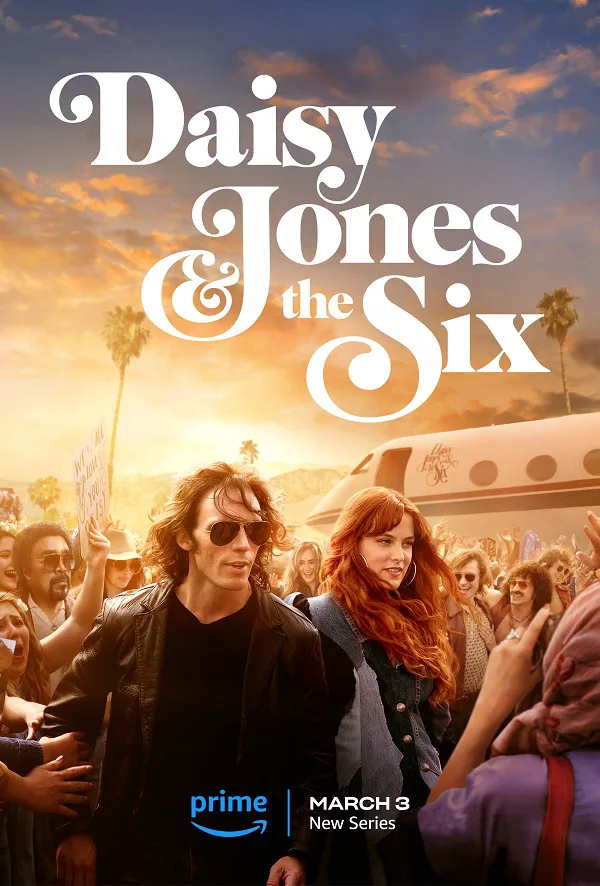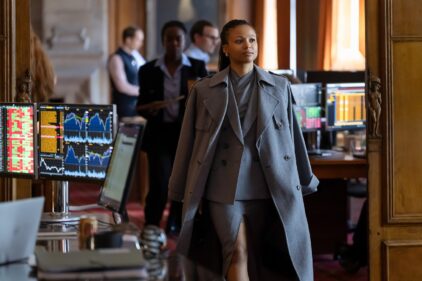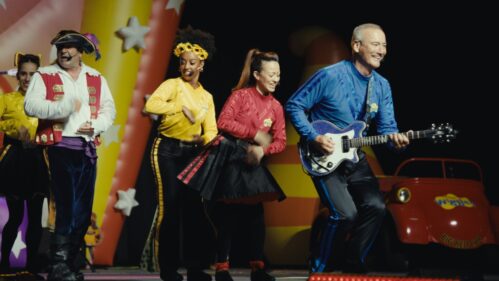Adapted from Taylor Jenkins Reid’s bestselling 2019 novel of the same name, “Daisy Jones & The Six” uses the tempestuous creative and personal dynamics within the band Fleetwood Mac to tell its own story of a ‘70s band that burned out instead of fading away. They were massive. Why did they break up so quickly? The series has a gorgeous cast of young talents, excellent period detail, and a rich source. But unfortunately, the show succumbs to the same problem as so many streaming series—sagging when it needs to narratively build momentum. Director James Ponsoldt (“The Spectacular Now”) establishes a wonderful set for the band in the first few episodes, but the show feels too content to repeat itself, feeling more and more like a cover of a cover.
The first two episodes engender enough goodwill to carry the show through some later rough spots, and it should be said that the cast is uniformly excellent to make even the mistakes tolerable. “Daisy” is initially framed as a documentary made two decades after The Six played their final show. Everyone has been gathered for interviews to explain the band’s rise and fall for the first time since they went their separate ways after a sold-out show at Soldier Field. So the bulk of the drama plays out as a flashback, starting with introductions to Daisy Jones (Riley Keough) and Billy Dunne (Sam Claflin), the Stevie Nicks & Lindsey Buckingham of this dynamic. The interviews establish the older versions of these characters and their bandmates as people with skeletons in their closets, and then the show reveals how they got buried.
The vibrant early episodes present young people on a collision course with creative destiny, two people tired of being underestimated by the people around them. They will be compared to “Almost Famous,” of course, but that’s not a criticism in that the show echoes that film’s joyous creative spirit at its best in these first chapters. As Billy gets his band together—guitarist brother Graham (Will Harrison), bassist Eddie Roundtree (Josh Whitehouse), drummer Warren Rojas (Sebastian Chacon), and keyboardist Karen Sirko (Suki Waterhouse)—while Daisy is being used by all of the men around her that don’t see her talent, there’s joy from the anticipation of their creative fusion. Ponsoldt and his team give these episodes a buoyancy, and Claflin and Keough really understand the “hungry artist” chapters best of all, making that blend of ambition and anxiety that often coalesces into creative genius. If anything, I wish the show spent more time before getting the title band together, letting The Six struggle in Pittsburgh and Daisy fight her way through the California music scene. It also would have helped define the other band members more before the focus becomes all about Daisy & Billy.
However, there’s definite magic when they get together, pushed by a famous producer named Teddy Price (Tom Wright). When Claflin and Keough’s voices harmonize in the studio on the earworm “Look at Us Now”—the original music in the show, often a problem in a project like this, is very strong—there’s power in just seeing the creative fusion work so well. The bulk of “Daisy Jones and The Six” consists of the band recording their only album Aurora, which means Daisy and Billy get close in ways that blur creative and personal lines, threatening Dunne’s marriage to Camila (the excellent Camila Morrone).
This is where “Daisy Jones” starts to lose its momentum. When Billy and Daisy get together on that breakthrough track, it’s fire. When they’re still bouncing writing ideas off each other and making goo-goo eyes at one another three hours later, the flame has fizzled a bit. And it’s here where it starts to lose something by being so focused on its two admittedly wonderful leads. It’s not a criticism of Keough and Claflin to say that the show falters by not giving more members of the band time in the spotlight. Yes, the arc of the drama for some of them is that they get pushed to the background, but they’re barely defined before that happens, so it lessens the impact.
There’s also an increasing sense that the show wastes its setting and period by staying in the studio or Billy’s house for such long stretches of time. When the series explores the life of Daisy’s best friend Simone (Nabiyah Be) and how her sexuality has to be hidden from the public eye while Daisy & Billy’s potential romance becomes a selling point for The Six, there are rich ideas about fame and double standards that should give a superficial show depth. But the writers don’t do enough with it, quickly returning to the love triangle at the center. Ultimately, it’s a show that feels small for a band that was reportedly so big.
Later in the series, a wonderful Timothy Olyphant, as the band’s tour manager, tells Billy and Daisy that they should consider some pyrotechnics in their show. Daisy responds, “I’m the fire.” By that time, I didn’t believe her. I wanted that passion of the first few episodes to sustain. And, yes, that’s part of the point—this is a story of creative fires put out by personal waters—but perhaps that point works better in a tighter format or on the printed page.
Lester Bangs famously said in “Almost Famous,” “The only true currency in this bankrupt world is what you share with someone else when you’re uncool.” “Daisy Jones & The Six” is too concerned about being cool instead of finding the true currency underneath the façade of rock history.
Whole series was screened for review. The first three episodes of “Daisy Jones & the Six” are now playing on Prime Video.




















